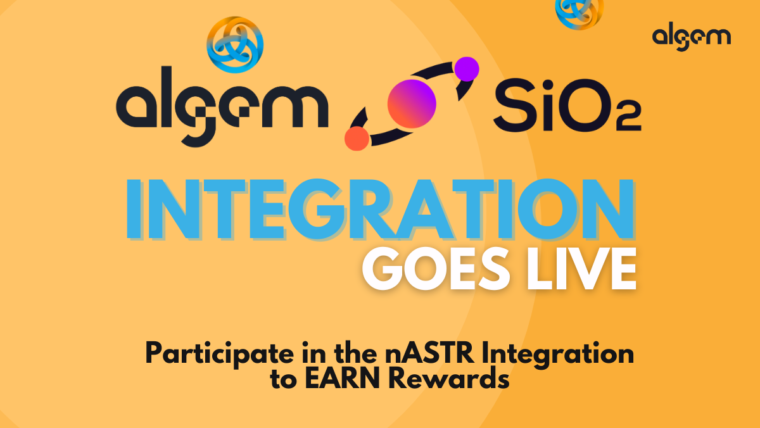Algem’s is a dApp built on Astar Network that enables you to remain liquid while staking. Astar Network is a parachain that is part of the Polkadot ecosystem. If you have no idea, what I’m talking about, you are in luck. This article will speak about Algem, Polkadot, and Astar Network.
We’ll go over what problem Algem is solving. What staking is and what liquid staking is.
But before we jump in, here’s a quick primer on the terms you’ll need to understand.
Index
- Proof-Of-Work vs. Proof-Of-Stake Blockchains
- What Is Polkadot?
- What Is Astar Network?
- The Problem With Staking
- What Is Algem?
Proof-Of-Work vs. Proof-Of-Stake Blockchains
At the heart of cryptocurrency are the blockchain and the act of mining. Mining is the process by which transactions are verified and added to the blockchain. Miners are rewarded for their work with crypto, but some miners have different priorities than others. For example, some miners are “staking” or “staking crypto.” They will buy or mine a currency like Bitcoin, Ethereum, or Dash and then stake it on the blockchain. This means they are using the currency and not trading it; they get a return on their investment. When the cryptocurrency’s price rises, the miner’s profit also increases.
Proof-of-Work was first implemented in bitcoin and was used to verify transactions and mine new blocks. In Proof-of-Work, computers in the network race to find the solution to a cryptographic problem. The computer that solves the problem the fastest wins the block and the fees associated with creating it. Unfortunately, one of the significant drawbacks of the Proof-of-Work algorithm is excessive energy consumption.
Proof-of-Stake, or POS, is a different system of cryptocurrency that is trying to become the new normal in the world of cryptocurrencies. The goal of POS is to create a system where the coins are not mined, but rather the users who hold the coins in their wallets and have the coins available for staking are the ones who get rewarded.
Proof-of-Stake is a viable alternative because it does not use much energy. Proof-of-Stake (PoS) is an algorithm for determining who will create the next block, or group of transactions, in a blockchain. It requires the person making the following block to put up some of their own coins from their account as collateral.
What Is Polkadot?
The Polkadot Protocol is a heterogeneous multi-chain platform designed to solve the scalability problem of Ethereum. The Polkadot Ecosystem is the name for the entire network of users and developers who have joined to create this open-source protocol.
Polkadot is a relatively new blockchain protocol that is said to fix the problems with existing blockchains. Polkadot is an interoperable and scalable blockchain network providing a crucial link between the world of public blockchains and private and consortium chains.
It is designed to provide a network of blockchains that can communicate, share data, and execute smart contracts. Polkadot will have the ability to connect public blockchains like Bitcoin and Ethereum with other blockchains that are not publicly distributed. In addition, Polkadot allows data and value to be moved across networks according to the rules of each network.
Polkadot is a blockchain project that seeks to become a universal language for the Internet. Polkadot achieves this by allowing developers to deploy their own blockchains while still allowing them to interact with other chains. These chains interact through a web of chains called “parachains.”
Polkadot ecosystem aims to create a reliable, scalable, decentralized network for decentralized applications. The Polkadot ecosystem is a platform that connects developers to the blockchain ecosystem. In addition, Polkadot provides developers with the tools and resources necessary to create decentralized applications.
Polkadot is a new blockchain platform with a suite of features that aim to solve the challenges faced by existing blockchains. The basic idea is to create a blockchain that can be more easily modified, upgraded, and integrated with other blockchains. The Polkadot blockchain consists of multiple parachains. These parachains can be run in parallel and communicate with each other through a process called “parachain hopping.”
What Is Astar Network?
Astar Network is a parachain built on Polkadot using its Substrate technology stack.
Astar Network — The Future of Smart Contracts for Multichain. Astar Network supports the building of dApps with EVM and WASM smart contracts and offers developers true interoperability with cross-consensus messaging (XCM).
Astar’s unique Build2Earn model empowers developers to get paid through a dApp staking mechanism for their code and dApps they build.
Astar’s vibrant ecosystem has become Polkadot’s leading parachain globally, supported by all major exchanges and tier 1 VCs. Astar offers the flexibility of all Ethereum and WASM toolings for developers to start building their dApps. To accelerate growth on Polkadot and Kusama Networks, Astar SpaceLabs offers an Incubation Hub for top TVL dApps.
Astar is a token-based ecosystem with a variety of features. The ecosystem makes it easy for developers to create decentralized applications that will allow users to communicate in a decentralized manner. It will also provide users with a way to securely store and exchange value with each other.
The Astar Network is a decentralized, peer-to-peer network that enables humans to interact and trade with one another while avoiding the need to go through a centralized intermediary.
Astar Network can do this through the use of smart contracts and distributed ledgers, which provide everyone with the opportunity to establish a secure connection and transactions.
Astar is a decentralized network capable of routing a message or content to any other node. The system is made up of several nodes that connect themselves to other nodes. The connection is made by a simple process of following the shortest path to the destination node. The message will be routed to another node if a node is unavailable.
The Problem With Staking?
The notion of staking has become quite popular in the cryptosphere, especially with the advent of Proof of Stake and other blockchain-based gambling sites. However, there are many reasons why staking is not the best idea. One problem with staking is the potential for a threat actor to buy many tokens, stake them, and then dump them to manipulate the market. One of the other problems with staking is the potential for a threat actor to buy many tokens, stake them, and then vote for themselves to be the block producer.
Staking vs. Yield Farming Crypto
A question I often hear from people who are new to crypto investing is whether to focus on yield or staking. With yield farming, you invest in the most profitable coins and earn a monthly income.
You invest in a diverse portfolio of coins, and rather than getting a monthly income, you get coins back as a reward for staking your investment.
Staking and yield farming are two methods of earning money in the crypto world. A significant difference between the two is that yield farming buys coins and holds them until they mature, while with staking, you buy coins and use them to stake a mining operation.
What Is Algem and What Problem Is It Solving?
Okay, so you’ve read this far. You can pat yourself on the back. Let’s talk about Algem and what problem Algem is solving.
Algem is a DeFi dapp built on Astar Network that aims to solve big problems that users face in the DeFi space.
The first problem is the problem of being illiquid while staking.
As you’ve read thus far, staking, while it has many benefits and allows users to earn an ROI, does limit them in the sense in that they are locked up while staking. This means they are illiquid while they are staking.
The second problem is the opportunity cost of choosing between staking and yield farming.
When you choose to stake or yield farm, by definition, you are choosing one option over the other. Since each choice has a value, the opportunity cost is the value you miss.
Let’s put a simple example to clear this up.
Let’s say staking is worth 100, yield farming is worth 200.
If you choose to yield farm, even though you’re gaining 200, your opportunity cost is 100 because you’re forgoing that option.
What if I told you that you could get 100 and 200 for a total value of 300?
That’s precisely what Algem enables you to do with your Astar tokens.
You see, the way it works is that when you stake your Astar tokens on Algem, you get a liquid token called nASTR…
With this liquid token, nASTR, you can do other DeFi activities on Astar Network (such as yield farming).
This is significant because you don’t have to choose between staking and yield farming. On Algem, you can do both.
Want To Join the Liquid Staking Revolution?
About Algem
Algem is a decentralized application built on the Astar Network and offers two main features: liquid staking and liquid lending. As their names suggest, these two options let ASTR holders keep their assets liquid while putting them to work. Also, the liquid staking and lending solutions let users use Algem’s liquid nASTR tokens across Astar’s DeFi ecosystem to earn staking rewards and make more money. In doing so, Algem supports other Defi protocols by providing liquidity and creating a sustainable and cooperative ecosystem on the Astar Network and Polkadot.








How we had been making Algemantis Nautilus Pass NFT
Everything You Need To Know About Liquid Staking On Astar Network
Partnership with Sirius Finance
Introduction in Algem